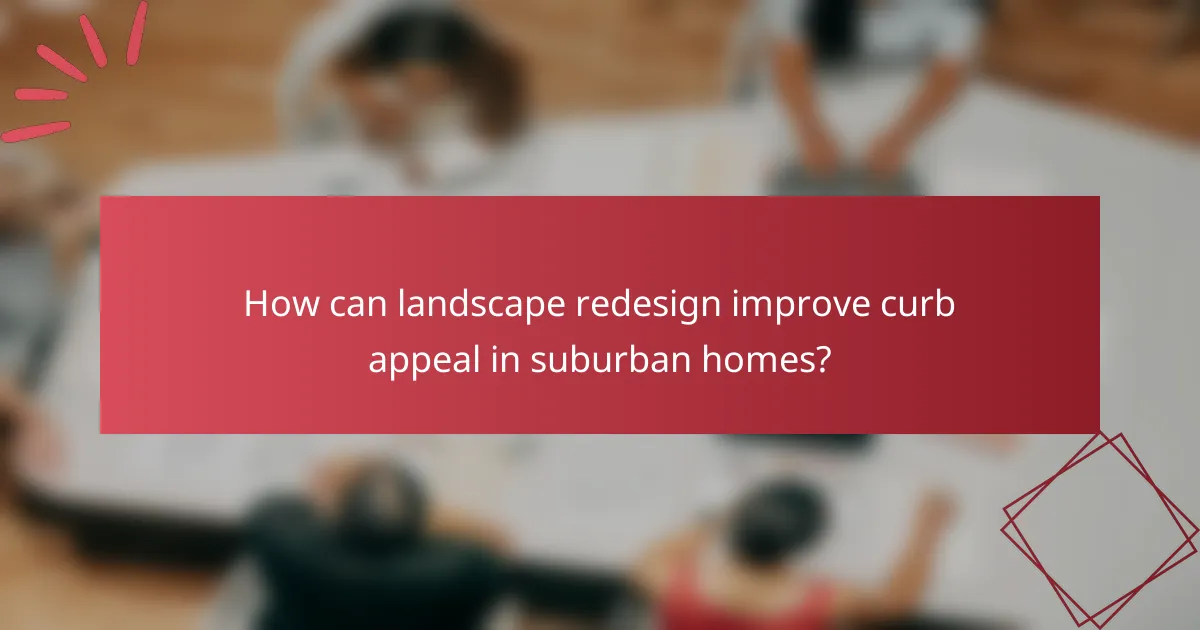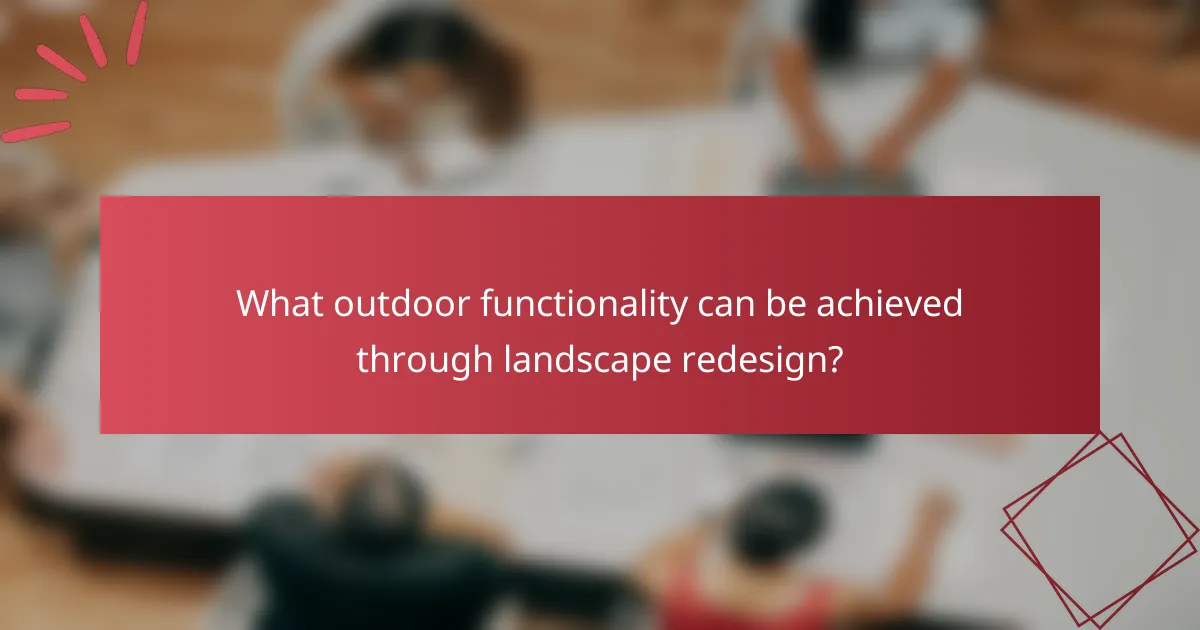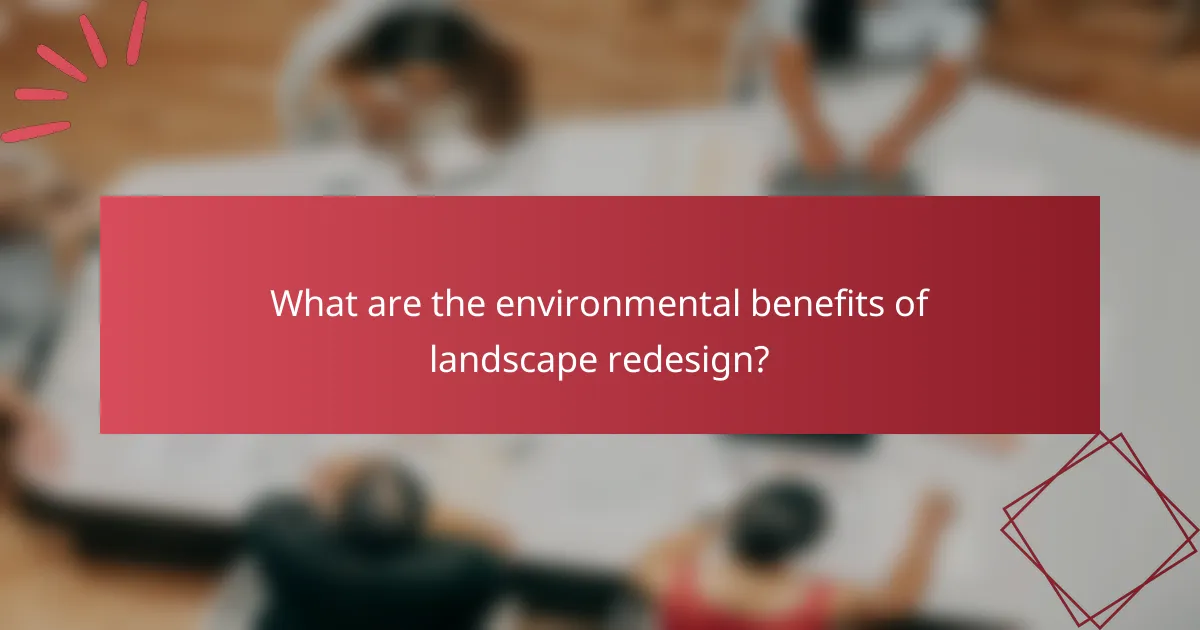Landscape redesign is a powerful tool for enhancing curb appeal, outdoor functionality, and environmental sustainability. By thoughtfully planning and implementing changes, homeowners can create visually striking exteriors that also serve practical purposes, such as improved drainage and increased privacy. Furthermore, these transformations can promote biodiversity and contribute to better air quality, making outdoor spaces not only beautiful but also beneficial for the environment.

How can landscape redesign improve curb appeal in suburban homes?
Landscape redesign can significantly enhance curb appeal by creating an inviting and visually appealing exterior. By focusing on aesthetics, functionality, and environmental benefits, homeowners can transform their properties into attractive spaces that stand out in suburban neighborhoods.
Enhanced visual aesthetics
Improving visual aesthetics involves selecting colors, textures, and layouts that complement the home’s architecture. Incorporating diverse plant life, decorative stones, and well-placed pathways can create a harmonious look. Consider using seasonal flowers to add vibrant colors throughout the year.
Additionally, maintaining a clean and tidy landscape, including regular pruning and mulching, contributes to an overall polished appearance. A well-designed landscape can make a strong first impression on visitors and potential buyers alike.
Increased property value
A well-executed landscape redesign can lead to a noticeable increase in property value, often by a significant percentage. Research indicates that attractive landscaping can yield returns of 10-15% on investment when selling a home. This makes it a wise financial decision for homeowners looking to enhance their property.
Investing in quality materials and professional design can further amplify this value. Homeowners should consider local market trends to determine which landscaping features are most desirable in their area.
Attractive plant selections
Choosing the right plants is crucial for creating an appealing landscape. Opt for native species that thrive in the local climate, as they require less maintenance and water. Incorporating a mix of perennials, shrubs, and ornamental grasses can provide year-round interest and texture.
Consider the growth habits and seasonal changes of plants to ensure a balanced look throughout the year. Grouping plants with similar water and sunlight needs can simplify maintenance and enhance visual cohesion.
Strategic hardscaping
Hardscaping elements such as patios, walkways, and retaining walls can add structure and functionality to a landscape. These features not only improve accessibility but also create defined spaces for outdoor activities. Use materials that complement the home’s style, like natural stone or pavers.
Incorporating hardscaping can also reduce maintenance needs by minimizing lawn areas. Ensure that hardscape designs allow for proper drainage to avoid water pooling and damage.
Lighting enhancements
Outdoor lighting plays a vital role in enhancing curb appeal during the evening hours. Strategically placed lights can highlight architectural features, pathways, and plantings, creating a warm and inviting atmosphere. Consider using LED fixtures for energy efficiency and longevity.
Incorporate a mix of ambient, task, and accent lighting to achieve a balanced effect. Solar-powered lights are a cost-effective option for homeowners looking to enhance their landscape without extensive wiring or installation costs.

What outdoor functionality can be achieved through landscape redesign?
Landscape redesign can significantly enhance outdoor functionality by optimizing space for recreation, improving drainage, increasing privacy, and creating accessible pathways. These improvements not only elevate the aesthetic appeal but also contribute to a more practical and enjoyable outdoor environment.
Improved outdoor living spaces
Redesigning your landscape can transform underutilized areas into vibrant outdoor living spaces. Consider adding features like patios, decks, or outdoor kitchens to create inviting areas for relaxation and entertainment. Incorporating comfortable seating and shade elements can enhance usability throughout different seasons.
When planning these spaces, think about the flow of movement and how they connect to your home. Using materials that complement your home’s architecture will create a cohesive look while maximizing functionality.
Efficient drainage solutions
Effective drainage is crucial in landscape redesign to prevent water pooling and erosion. Implementing features such as rain gardens, permeable pavers, and swales can help manage excess water while enhancing the landscape’s aesthetic. These solutions not only protect your property but also promote groundwater recharge.
When designing drainage systems, consider local rainfall patterns and soil types. Proper grading and the strategic placement of plants can further improve drainage efficiency, ensuring your landscape remains healthy and functional.
Increased privacy with plantings
Using strategic plantings can significantly enhance privacy in your outdoor spaces. Tall shrubs, hedges, and trees can create natural barriers that shield your yard from neighbors and street views. Selecting evergreen varieties ensures year-round privacy, while deciduous plants can provide seasonal interest.
When planning for privacy, consider the mature height and spread of plants to avoid overcrowding. Layering different types of plants can create a lush, secluded environment while adding texture and color to your landscape.
Functional pathways and seating areas
Creating functional pathways and seating areas is essential for enhancing accessibility and usability in your landscape. Well-designed paths can guide visitors through your garden, connecting different areas while providing a clear route. Materials like gravel, stone, or brick can be used to create durable and visually appealing walkways.
Incorporating seating areas along these paths encourages relaxation and interaction with the landscape. Consider placing benches or chairs in scenic spots to maximize enjoyment of your outdoor space. Ensure that these areas are easily accessible and integrated with the overall design for a seamless experience.

What are the environmental benefits of landscape redesign?
Landscape redesign offers several environmental benefits, including enhanced biodiversity, improved air quality, and effective water conservation. By incorporating sustainable practices, these changes not only beautify outdoor spaces but also contribute positively to the ecosystem.
Enhanced biodiversity
Redesigning landscapes can significantly enhance biodiversity by creating habitats for various species. Incorporating a mix of plants, trees, and shrubs attracts pollinators like bees and butterflies, as well as birds and beneficial insects.
To promote biodiversity, consider planting native species that are well-adapted to the local environment. This reduces the need for chemical fertilizers and pesticides, fostering a healthier ecosystem.
Improved air quality
Landscapes rich in vegetation can improve air quality by filtering pollutants and producing oxygen. Trees and plants absorb carbon dioxide and release oxygen, contributing to cleaner air.
Strategically placing trees around buildings can also reduce energy consumption by providing shade, which lowers the need for air conditioning. This not only benefits the environment but can also lead to cost savings on energy bills.
Water conservation techniques
Implementing water conservation techniques in landscape redesign can significantly reduce water usage. Techniques such as xeriscaping, which involves using drought-resistant plants, can minimize irrigation needs.
Additionally, installing rain gardens or permeable paving can help manage stormwater runoff, allowing water to infiltrate the ground rather than overwhelming drainage systems. This practice supports groundwater recharge and reduces erosion.
Native plant integration
Integrating native plants into landscape redesign is crucial for environmental sustainability. Native plants are adapted to local climates and soil conditions, requiring less water and maintenance compared to non-native species.
Using native plants can also support local wildlife by providing food and shelter, creating a balanced ecosystem. Consider sourcing plants from local nurseries to ensure they are suited for your area and to promote regional biodiversity.

What factors should be considered when planning a landscape redesign?
When planning a landscape redesign, key factors include budget constraints, climate and soil conditions, and maintenance requirements. These elements will significantly influence the design choices and overall success of the project.
Budget constraints
Establishing a clear budget is essential for any landscape redesign. Consider both initial costs and long-term expenses, including materials, labor, and ongoing maintenance. A typical residential landscape project can range from a few thousand to tens of thousands of dollars, depending on the complexity and scale.
Prioritize your spending by focusing on elements that will enhance curb appeal and functionality first. For instance, investing in quality plants and hardscaping can yield better results than opting for cheaper, lower-quality options.
Climate and soil conditions
Understanding your local climate and soil conditions is crucial for selecting appropriate plants and materials. Different regions experience varying temperatures, rainfall, and sunlight, which affect plant growth and landscape durability. For example, drought-resistant plants are ideal for arid climates, while moisture-loving species thrive in wetter areas.
Soil quality also plays a significant role in plant health. Conduct a soil test to determine pH levels and nutrient content, which will guide your plant selection and any necessary amendments. This ensures that your landscape will be both beautiful and sustainable.
Maintenance requirements
Maintenance is a critical consideration in landscape redesign, as it impacts the long-term viability of your design. Choose plants and materials that align with your willingness and ability to maintain them. Low-maintenance landscapes often use native plants, which require less water and care.
Develop a maintenance plan that includes regular tasks such as pruning, weeding, and fertilizing. Consider seasonal changes and how they affect your landscape’s upkeep. By planning for maintenance, you can enjoy your redesigned space without overwhelming effort.

How to choose a landscape designer in urban areas?
Choosing a landscape designer in urban areas involves evaluating their experience, design style, and understanding of local regulations. Look for professionals who can enhance your outdoor space while considering environmental factors and urban constraints.
Evaluate their portfolio
Reviewing a designer’s portfolio is crucial to understanding their style and capabilities. Look for projects that reflect your aesthetic preferences and demonstrate their ability to work within urban settings. Pay attention to how they incorporate functionality and curb appeal in their designs.
Check references and reviews
Contact previous clients to gain insights into the designer’s work ethic, reliability, and communication skills. Online reviews can also provide valuable information about their reputation. Aim to find a designer who has consistently positive feedback and a strong track record in urban projects.
Discuss your vision and needs
Clearly communicate your vision and specific needs to potential designers. Discuss your goals for curb appeal, outdoor functionality, and environmental benefits. A good designer will listen and offer suggestions that align with your objectives while considering the unique challenges of urban landscaping.
Understand costs and budget
Landscape design costs can vary widely based on project complexity and location. In urban areas, expect to budget for both design fees and installation costs, which may range from a few hundred to several thousand dollars. Be upfront about your budget to ensure the designer can work within your financial constraints.
Verify knowledge of local regulations
Urban landscaping often involves specific regulations regarding zoning, permits, and environmental considerations. Ensure your designer is knowledgeable about local laws and can navigate any necessary approvals. This expertise can save you time and prevent potential legal issues down the line.



